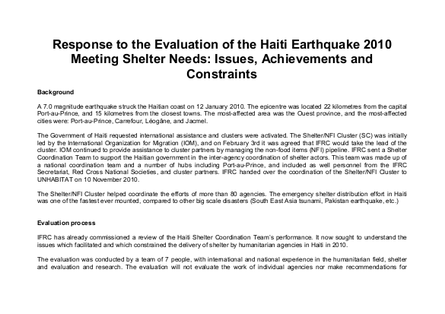
A 7.0 magnitude earthquake struck the Haitian coast on 12 January 2010. The epicentre was located 22 kilometres from the capital Port-au-Prince, and 15 kilometres from the closest towns. The most-affected area was the Ouest province, and the most-affected cities were: Port-au-Prince, Carrefour, Léogâne, and Jacmel. The Government of Haiti requested international assistance and clusters were activated. The Shelter/NFI Cluster (SC) was initially led by the International Organization for Migration (IOM), and on February 3rd it was agreed that IFRC would take the lead of the cluster. IOM continued to provide assistance to cluster partners by managing the non-food items (NFI) pipeline. IFRC sent a Shelter Coordination Team to support the Haitian government in the inter-agency coordination of shelter actors. This team was made up of a national coordination team and a number of hubs including Port-au-Prince, and included as well personnel from the IFRC Secretariat, Red Cross National Societies, and cluster partners. IFRC handed over the coordination of the Shelter/NFI Cluster to UNHABITAT on 10 November 2010. The Shelter/NFI Cluster helped coordinate the efforts of more than 80 agencies. The emergency shelter distribution effort in Haiti was one of the fastest ever mounted, compared to other big scale disasters (South East Asia tsunami, Pakistan earthquake, etc.)
Resource collections
- Evaluating humanitarian action
- UN Habitat - Urban Response Collection
- Urban Response - Urban Crisis Preparedness and Risk Reduction
- Urban Response Collection - Community Engagement and Social Cohesion
- Urban Response Collection - Economic Recovery
- Urban Response Collection - Environment and Climate Change
- Urban Response Collection - Housing, Land and Property
- Urban Response Collection - Urban Crisis Response, Recovery and Reconstruction
- Urban Response Collection - Urban Resilience